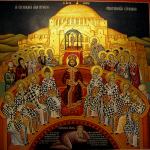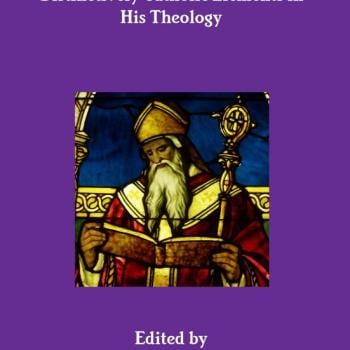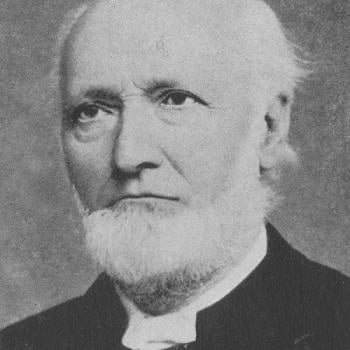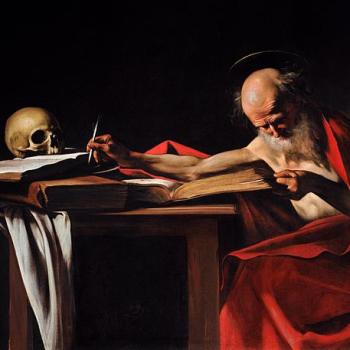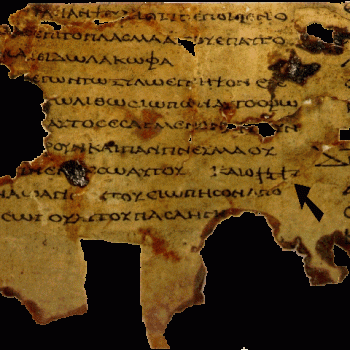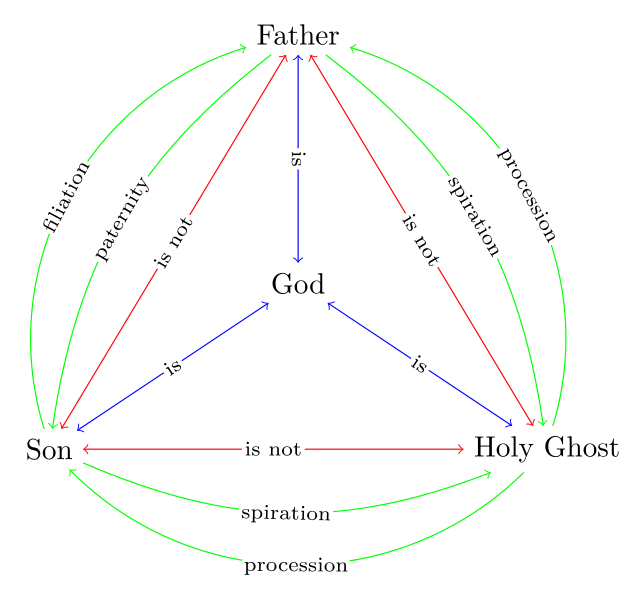
Preliminary background: the filioque (Latin for “And the Son”) is the theological notion that the Holy Spirit proceeds from the Father and the Son, Jesus. This clause is included in the Nicene Creed — seen as a legitimate development — in the Western Catholic Church, but not in the Eastern Orthodox Church, which regards it as a late corruption and heresy. It was not really a matter of controversy until the time of Photius in the second half of the 9th century, but since then it has been of central importance in the East-West schism which finalized in the 11th century. Western, Latin theologians and Fathers (and many Eastern as well) found biblical support for the filioque in such passages as John 14:16; 15:26; 16:7,13-15; Rom 8:9; Gal 4:6; and Phil 1:19.
The following exchange is between the author, William Klimon (Eastern Catholic) and two Orthodox Christians (words in green). Citations from Church fathers and later Orthodox writers will be in blue:
****
It is clear that Rome resisted the heretical addition to the Symbol of Faith. (Pope Leo III (795-816) forbade any interpolations or alterations in the Symbol of Faith. He ordered the Symbol of Faith, without filioque, to be engraved in Latin and Greek on two silver plates on the wall of St. Peter’s in Rome. Pope John VIII (872-882) affirmed the teaching of the Council of Constantinople (A.D. 879-880) which reaffirmed the creed of A.D. 381 and condemned ANY and ALL changes to the Symbol.) Therefore, it should not be surprising that communion was maintained between the East and Rome. It should be noted that the East, upon becoming aware of the existence of the heresy, made explicit their objection — notably St Photius.
A couple of thoughts:
(1) It is quite right that Leo affirmed the Constantinopolitan Creed. It is the Creed of the Church. It is wholly right, good, and true. Most Eastern Catholics sing the Creed that way. The present pope has sung it that way, too. But, I would submit, the Creed with the Filioque is also wholly right, good, and true.
(2) The idea of the inviolability of the Creed is both true and false. It is true that no new faith may be introduced. It is false that there may be no actually expansion of the Creed that clarifies and solidifies the faith.
Here are a few thoughts of mine, that are somewhat on point, from an old essay:
Just as at the First Council of Nicea (325), the Creed (“of the 318 Fathers,” i.e., of the 318 bishops at Nicea) agreed upon simply states: Kai eis to Hagion Pneuma. It says nothing about the procession of the Spirit, or His adoration or glorification, etc. This was “remedied” at the First Council of Constantinople (381). But the Constantinopolitan Creed (the “Creed of the 150 Fathers”) was not immediately agreed upon by the whole Church, and both Creeds existed side-by-side. The agreement happened only at Chalcedon (451). Even then, the Fathers of that great Council proposed yet another credal formulation that concentrates on Christological definitions. But wait, we’re not done yet. The Third Council of Constantinople (680) “enlarged the Creed of Chalcedon, notwithstanding the solemn prohibition of the Council of Chalcedon, by adding a horos, or dogmatic definition to the effect that Jesus Christ had two distinct and inseparable wills,” etc.–Philip Schaff, The Creeds of Christendom (1931), vol. 2, p. 72. The Creed has been neither as static nor as exhaustive as you might believe. The Filioque is yet another addition to our credal understanding.
And this from another essay of mine:
The history of the Creed makes clear that it was never as sacrosanct as the Orthodox would make it out to be. There are even differences between the Greek and Latin textus recepti about which the Orthodox don’t complain (the Latin has the additional Deum de Deo (“God from God”) clause, e.g., which DOES appear in the Creed of Nicea but NOT in the Creed of Constantinople).
There is no evidence that the filioque was embraced in the West before the Council of Toledo (A.D. 587). This is hardly ‘very early’.
When we consider (i) the Christological affirmations of Constantinople III (680/81) 100 years later, and (ii) the lagging history of pneumatology, i.e., the theology of the Holy Spirit seems always to have come after other issues, I think the late 6/c is fairly early.
Besides there are plenty of earlier testimonies among the Western and Eastern (!) Fathers!
If it were true that the Romans do not believe the Son to be equally the ’cause’ of the Holy Spirit with the Father, (1) They would have rendered the English translation of the Symbol properly, rather than maintaining all three errors in the Latin version, including the filioque.
(1) Yes, the “Romans” were particularly concerned with the “English translation of the Symbol” in the 6/c!
(2) The problem is one of translation. The Latin processio is used in two senses, originating (which the Spirit does from the Father alone) and proceeding (more specifically) (which the Spirit does from the Father and the Son, or through the Son).
(3) This hardening and misunderstanding of patristic pneumatology comes, unfortunately, from St. Photius:
[F]rom 867 onwards Photius condemned the Filioque in a series of texts and formulated the doctrine of the procession of the Holy Spirit from the Father alone: ek monou tou Patros. He did not understand the homogeneity of the Latin idea of the mystery of the Trinity, according to which the distinction between the Person in their perfect consubstantiality is derived from their relationship and the opposition of their relationship–the Father and the Son are relative to one another–and that relaitonship is one of origin and procession. Photius, however, believed that the Persons were distinguished by personal properties that could not be communicated. . . .
Photius regarded the monarchy of the Father as the principle both of the Spirit and of the monogenous one, and as the principle of their consubstantiality. Whereas the Greek Fathers saw this monarchy as moving dramatically in a straight line, from the Father through the Son in the Spirit, however, Photius adopted a scheme consisting of two branches:
Son Father <>per
Filium and even Filioque, Photius enshrined pneumatology in a form of expression which put out of the question an agreement with the West or even with those Latin Fathers whom the Orthodox Christians accept as their own. . . . We must . . . take Photius’ arguments seriously–the more so because the Greek Church has taken over his theology–without at the same time losing sight of those Fathers whose work Photius himself tended to leave aside.
(Yves Congar, I Believe in the Holy Spirit [Eng. trans. 1983], vol. 3, pp. 58-59)
And Photius certainly taught the bifurcated system Card. Congar sketched. See Photius, Contra Man. III, 17 (PG 102, 168B), and Amph., q. 188 (PG 101, 909B). In fact, apparently the diagram I reproduced is attributed to St. Photius!
(2) They would not teach that the Holy Spirit is the result of the love between the Father and the Son. Of course, the idea of the Holy Spirit being the love between the Father and the Son leads directly to the filioque. Doran taught that the human family was an ‘icon’ (his term, correctly defined as ‘image’) of the Holy Trinity in that the love between husband and wife produces a child as the love between the Father and Son gives procession to the Holy Spirit. Such teaching clearly subordinates the Holy Spirit to the other Persons. Such teaching clearly makes the Father and the Son two separate and equal sources. Such teaching is clearly unknown in the Church.
The notion that the Spirit is in some way the relationship, the love, of the Father and the Son is especially Western. But it is not foreign to the East:
***
The Holy Spirit is “the bond of the Trinity.” – St. Epiphanius of Salamis, Ancoratus, 7 (PG 43:23B).
The Spirit of the Word is like a love of the Father for the mysteriously begotten Word, and it is the same love that the beloved Word and Son of the Father has for the one who begot him. That love comes from the Father at the same time as it is with the Son and it naturally rests on the Son. – St. Gregory Palamas, Chapters, 36 (PG 150:1144D-1145A).
[I]f God, in the Holy Trinity, is Love, then the Holy Spirit is Love of that love.– Sergius Bulgakov, La Paraclet (1946), p. 74.
Commenting on St. Andrei Rublev’s Icon of the Trinity, the Holy Spirit “is in the middle of the Father and the Son. He is the one who brings about the communion between the two. He is the communion, the love between the Father and the Son. That is clearly shown by the remarkable fact that the movement comes from him. It is in his breath that the Father moves into the Son, that the Son receives his Father and that the word resounds.” – Paul Evdokimov, “L’icone”, La vie spirituelle, 82 (1956), pp. 24ff.
As the late Yves Cardinal Congar commented, “These pieces of evidence are not sufficient, of course, to form a theological tradition, but they do create a link and a point to an openness. ‘The walls of separation do not reach as high as heaven.'” – Yves Congar, I Believe in the Holy Spirit(Eng. trans., 1983), vol. 3, p. 89.
***
It is heresy, embraced by the West. No Orthodox Catholic Christian will ever embrace it for to embrace it is to cease being an Orthodox Catholic Christian.
Funny, how you passed over my invocation of SS. Cyril of Alexandria, Epiphanius, Gregory of Nyssa, Maximus the Confessor, and John of Damascus, who all embraced it. Are they not Orthodox Catholic Christians?
We’ll have to disagree. Anything after Nicaea is, in my opinion, not early.
Well, then the political intrusion of Constantinople into the Petrine hierarchy of patriarchates–Rome, Alexandria, Antioch–is not early.
The understanding of the two natures and two wills in Our Lord is not early.
The cult of images is definitely not early.
And St. Photius’ pneumatology is even less early!
Besides there are plenty of earlier testimonies among the Western and Eastern (!) Fathers!
Where?
Well, here are some examples from the Eastern Fathers:
***
(1) St. Athanasius (d. 373), in at least three places, refers to the “dependence in origination of the Spirit in the Son.” He uses the expression para tou Logou in:
– Contra Arian. III, 24 (PG 26, 376A) – Ad Ser. I, 20 (PG 26, 580A) – Id., III, 5 (PG 26, 632C).
(2) St. Epiphanius (367-403) refers to the Spirit as proceeding from the Father and receiving from the Son:
– Ancoratus, 6 (PG 43, 25C) – Id., 7 (PG 43, 28A) – Id., 11 (PG 43, 36C) – Id., 67 (PG 43, 137B) – Id., 73 (PG 43, 153A) – Id., 120 (PG 43, 236 B) – Panarion, Haer. LXII (PG 41, 1056)
He also said that the Spirit is (“has his consubstantial being”) from the Father and the Son:
– Ancoratus, 8 (PG 43, 29C) – Id., 9 (PG 43, 32C) – Id., 67 (PG 43, 137B) – Id., 70 (PG 43, 148A) – Id., 71 (PG 43, 148B) – Id., 72 (PG 43, 152B) – Id., 75 (PG 43, 157A) – Panarion, Haer. LXIX, 54 (PG 42, 285D).
(3) St. Cyril of Alexandria (d. 444) used a great variety of formulae to express the relationship between the Spirit and the Son:
The Spirit is proper to the Son
–Comm. in Ioel XXXV (PG 71, 377D) –De recta fide ad Theod. XXXVII (PG 76, 1189A) –De SS. Trin. Dial. VII (PG 75, 1093A) –Comm. in Ioan. II (PG 71, 212B)
He comes from the Son
– see texts above
He proceeds from the Son
– Adv. Nest. IV, 1 (PG 76, 173A-B)
He proceeds from the Father and the Son
– De recta fide ad Reg. Or. alt. LI (PG 76, 1408B) – De ador. I (PG 68, 148A)
He proceeds from the Father through the Son
– De ador. I (PG 68, 148A) – Adv. Nest. IV, 3 (PG 76, 184D)
(4) I have already cited the evidence from St. Maximus the Confessor for the “through the Son.” He also used the expression: dia mesou tou Logou, “by means of the Word.” – Quaestiones et dubia, Interr. XXXIV (PG 90, 813B).
(5) There is more evidence from SS. Gregory of Nyssa and John of Damascus, if you are interested – I get the sense, though, that you are not.
Don’t twist my words. If Rome were interested in a proper English translation of the Symbol of Faith, there would be no ‘and the Son’ since the English word ‘proceeds’ refers to origin.
Actually Cardinal Congar proposed a somewhat better translation, that captures the two meanings of the Latin:
“from the Father as the absolute Source and from the Son”
and he also pointed to the more readily acceptable patristic formula:
“from the Father through the Son.”
See Congar, op. cit., p. 206.
Do you reject the Western Fathers who formulated this Western understanding? Of course, if you do that you must also reject the Fifth Holy Ecumenical Council (Constaninople II), which affirmed:
We further declare that we hold fast to the decrees of the four Councils, and in every way follow the holy Fathers . . . Hilary . . . Ambrose . . . Augustine . . . Leo and their writings on the true faith [listing just the Western Fathers mentioned by the Council]. See Constantinople II, Acta, Session I.
(4) What are the other Latin errors in the Creed?!?!
1) The extra ‘God from God’ inserted before ‘Light of Light’ 2) Changing ‘was incarnate of the Holy Spirit AND the Virgin Mary’ to ‘was incarnate of the Holy Spirit OF the Virgin Mary’ 3) The filioque.
(1) I don’t possibly see how Deum de Deo could be an error! It comes straight from the Symbol of Nicea I (325). For the text, see Philip Schaff, The Creeds of Christendom (3d ed. 1931), vol. 2, p. 60. The original form of the Symbol was read out and approved at the Holy Ecumenical Council of Chalcedon (451), along with the Niceno-Constantinopolitan version. See Chalcedon, Acta, Session II. So do you reject Nicea I and Chalcedon as well?!?!
(2) The textus receptus in Greek reads:
kai sarkothenta ek pneumatos hagiou kai Marias tes parthenou kai enanthropesanta
The textus receptus in Latin is:
et incarnatus est de Spiritu Sancto ex Maria virgine, et homo factus est
This gets translated variously, but de and ex are synonymous. In fact, in that line from the Creed, their usage is a kind of correlative form that Latin favors, which we could translate as: “. . . from/of the Holy Spirit and from/of the Virgin Mary . . .”
The meaning is clearly the same in the Latin and the Greek!
I tire of this. The filioque is heresy, plain and simple. Frankly, I’m tired of the Roman equivocations and attempts to ‘clarify’ (e.g. the September 1995 document by the Vatican Pontifical Council for Promoting Christian Unity as published in L’Osservatore Romano). If they would simply return to the ancient Faith, this problem – a problem created by the Roman Catholics – would no longer exist. Of course, along with the whole idea of papal infallibility, the Roman Catholics have painted themselves into a theological corner.
I would guess it would become tiresome continually to be wrong. As we can see from the above cited passages, the ancient faith included the Filioque! So we have never left it! I do pray for the resumption of communion between us, though.
A second Orthodox participant wrote:
From the Orthodox perspective, the word “proceeds” (processio in Latin) is supposed to translate a Greek word which specifically refers to eternal “hypostatic origin.” We Orthodox make a distinction between two different “kinds” of procession. The first type is “hypostatic procession”. In this case, the term “procession” is used generally and could mean “begotten-ness” as in the case of the Son, or “proceeding from the Father” (used in a more specific sense) in the case of the Spirit . . .
But we do also acknowledge another general “kind” of “procession”. We would call it “energetic procession.” This gets into our understanding and distinction that we make between the Divine Essence (which is transcendent and non-accessable to anyone but the Trinity in any sense) and the Divine Energies (in which we participate and through which we become “partakers of the Divine Nature”). The Divine Energy is the Life of God which “surrounds” the Divine Essence. It is one Energy, but we experience it in multiplicity and give it various names (all the names of the attributes of God). It is still the Trinity, the Divine Energies are thus thus Uncreated (as the Trinity is Uncreated). The Divine Energies is the “mode” (if you will) of eternal manifestation of the Trinity. In this sense, we can surely say that the Spirit proceeds “energetically” from the Father through the Son.
If this is not (vain) philosophizing, I don’t know what is! These distinctions are foreign to the Western and the Alexandrian traditions. I don’t necessarily reject them–but I must point out that this is clearly an example of:
(1) A kind of philosophical theology that many Orthodox condemn when practiced by Latin theologians
(2) A development of doctrine, perhaps anticipated by some of the Fathers, perhaps drawn from the witness of Holy Scripture, but clearly a development of the ante-Nicene understanding that rejected “processions” from the Deity that were not personal/hypostatic.
So there is a door that is “open” theologically so to speak.
Indeed. I agree. But we must push it open more widely – to see the witness of all the Holy Fathers of the faith.
We would argue that if the patristic texts are carefully examined, the distinction between “energetic procession” and “hypostatic origin or procession” will be seen. Every patristic text that seems to endorse a filioque, we would understand as speaking about “energetic procession.”
Yes, that might be the latter-day understanding of St. Gregory Palamas, e.g., but it simply does NOT explain ALL of the patristic evidences! St. Athanasius the Great, e.g., affirmed that there were no processions from the Deity which were not personal.
Again, we would say that if you examine the texts, you will find nothing specifically refering to hypostatic origin in these passages. You will, if anything, find evidence that it refers to “energetic procession” as I feebly tried to explain above. Perhaps other Orthodox can correct my poor attempt at explaining this.
Wrong. In several of the passages I cited the meaning is clearly that the Son has some role in the eternal state of the Spirit. He is not the principle, but He has some role. I salute your open door. But we must face ALL of the patristic evidence fairly–especially when our traditions (which are ONE after all) SEEM to diverge so sharply.
The first Orthodox mentioned at the beginning respoinded:
When the capital of the Roman Empire was moved East to New Rome (Constantinople) in the fourth century, the West was pretty much isolated, especially the western-most provinces. By the sixth century, the Filioque heresy had taken root and by the close of the eighth century that heresy was firmly established amongst the Franks. Old Rome resisted this heresy for some time, but with diminishing contact with the East and a growth in the influence of the Franks, Old Rome succumbed to this heresy in the early 11th century. Later in the same century, Old Rome separated from the Church and went with the heretical Franks.
Here are some interesting thoughts from the late Yves Cardinal Congar, O.P., one of the great historical theologians of the 20/c:
[I]t is extremely important to note that the West professed the Filioque, through its Fathers and its councils, at a time when it was in communion with the East and the East was in communion with the West.
(Yves Congar, I Believe in the Holy Spirit (Eng. trans. 1983), vol. 3, p. 50)
Cardinal Congar went on to list all of the Western Fathers who professed the filioque:
SS. Hilary of Poitiers (the “Athanasius of the West”), Ambrose, Augustine, Leo the Great, Fulgentius of Ruspe, Eucherius of Lyons, Faustus of Riez, Avitus of Vienne, Gennadius of Marseilles, Julian Pomerius of Arles, Paschasius, Boethius, Cassiodorus, Gregory the Great, and Isidore of Seville.
Western Councils and Creeds that taught the filioque are noted:
The Sixteen Councils of Toledo (440-675), the Quicumque (Athanasian Creed), and the Synod of Hatfield (680).
Cardinal Congar lists these Eastern Fathers who “assumed or stated that the Spirit was dependent in his eternal subsistence on the Son”:
SS. Epiphanius and Cyril of Alexandria.
And these Eastern Fathers who “spoke of a procession from the Father through the Son”:
SS. Gregory of Nyssa, Maximus the Confessor, and John Damascene.
Indeed we know that the West professed the filioque very early and was still in communion with the East. Here is what St. Maximus the Confessor, the Proto-Greek Catholic theologian, said on the matter, by way of explanation to his fellow Greeks:
[The Romans] have produced the unanimous evidence of the Latin Fathers, and also of Cyril of Alexandria, from the study he made of the gospel of St. John. On the basis of these texts, they have shown that they have not made the Son the cause of the Spirit–they know in fact that the Father is the only cause of the Son and the Spirit, the one by begetting and the other by procession–but that they have manifested the procession through him and have thus shown the unity and identity of the essence. – St. Maximus, Letter to Marinus, PG 91, 136.
As we can see, the filioque is the teaching of the Church! The East may understand it differently – in a complementary way to that of the West. The East may not sing it in the Creed. But, properly understood, it IS the faith of the Church. If one condemns the filioque, he condemns the whole Western church and he condemns the Eastern church that was in communion with the West! Indeed, he either cuts himself off from the whole Church, or he condemns himself!
***
(originally July 1997)
Photo credit: Shield of the Trinity with the four relations of (depicted by green arrows); posted by Geremia [public domain / Wikimedia Commons]
***


